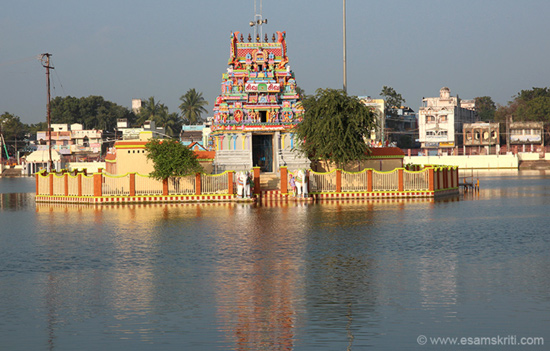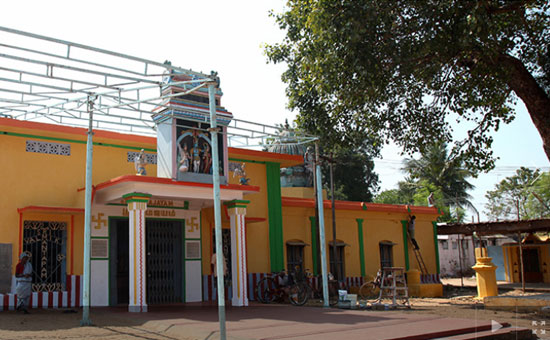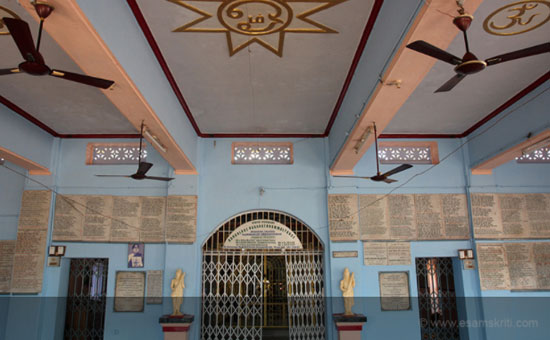- Know
about the life and music of the great saint poet Thyagraja.
Music
is one of the oldest and finest forms of human expression and devotion.
The
scriptures extol music as: Chaitanyam
Sarvabhootanaam, Vivritham
Jagatatmana, Nadbrahmam Tadanandam,
Advaita Upasmahey. This means, ‘we adore the Brahman, who has created this world out of His very self, which is manifested as sound, which is the essence of delight and that is without a second’. Nada means sound and Brahman means the omnipresent Reality. So Nadopasana means worship of God through the medium
of sound/music.
Devi
in the form of Shakti is called Nadaswarupini
(the divine form of sound). The three lines in Her neck represent: Ghati (recitation), Ghamaka (primordial sound-Om), and Geetam (Chanting/ keertan). Many immortal works are set to music.
The Vedas have their own musical charm when chanted properly. India has
produced many poet saints like, Purandaradasa, Meera Bai, Andal and Saint
Thyagaraja.
Among
them, Thyagaraja stands out for his prodigious output of Kritis.
First
published in Journal of Bharatiya Vidya Bhawan.
 Water Tank outside Thyagaraja Mandir, Thiruvarur.
Water Tank outside Thyagaraja Mandir, Thiruvarur.
Thyagaraja is the Raja (king) among composers in Carnatic music. It is believed that the word Carnatic comes from the root ‘karnataka’ (meaning that which is pleasing to the ear- karna).
In
Carnatic music the names of the composer appear in the lyrics. Each composition
has its own identity, style of presentation, raga, rhythm and philosophical/
emotional content. The choice of words, phrases and melody appeal both to the
heart and intellect.
Thyagaraja
who belonged to a Telugu Brahmin family was born in 1767, in Tiruvarur in
Tanjore district in Tamil Nadu. Thyagaraja got initiated into literature by his
learned father and to music by his mother who had a sweet voice and used to
sing traditional devotional songs. He grew up in an atmosphere of learning,
music and spirituality that helped to groom his musical talent and devotion.
Though
he had composed over 24,000 Kritis,
only 800 are available today through his line of disciples. He lived a simple life and spurned all offers of wealth
and honour from everybody, including kings. This is exemplified by his composition called ‘Nidhi Chaala Sudama’ (Sudama was another name of Kuchela). Due to this his relatives were against him and harassed him in many ways.
Thyagaraja’s personal life symbolises fervent piety, absolute devotion, total surrender to God and gentle affability. He said that the dip in the nectar of devotion and a song in praise of Rama were far dearer to him than everything else. In many of his songs we can see his enlightenment and realisation of God. But Rama was no abstract God for him.
To
him, Rama was a friend, philosopher and guide. His compositions reflect his
reactions to this relationship with the Lord.
The
range of his ragas was vast, staggering, and his mode of appealing to Sri Rama,
absorbing, poignant and soul stirring, from the most intimate approach to the
most philosophical. His compositions exude love, prayer and appeal. His
devotion and bhakti have no parallel. He considered Lord Rama as Parabrahma, the one Supreme God, and that, too, as the source of everything. He appealed to Sri Rama like a child, to complain, explain, solicit, beg, protest, get angry, and even weep. All his compositions relate vividly to his mental frame, poise and emotion at the given time. Sri Rama was his very soul and existence. Thyagaraja’s kritis show his literary prowess, philosophical insight, use of apt metaphors, and superior quality of music, all fused into one divine creation. He has composed kritis in almost all ragas.
His
Pancharatna kriti, Endaro Mahanubhavulu is very popular.
When Shatkala Govinda Marar, a highly talented musician, sang the Ashtapati, Chandana Charchita accompanied by a
seven-stringed Tambura, Saint Thyagaraja was stunned by the scholarship and
proficiency of Marar. Immediately he sang the kriti, Endaro Mahanubhavulu in Sriragam in praise of all Mahanubhavas,
which is a salutation to great souls of all times and ages.
Thyagaraja’s life is an epitome of simplicity, nobility and virtue. The intensity of the poet’s emotion can be felt when singing and/or hearing his songs, when they are sung with Bhava suiting to the song and its meaning. They transcend you into another world of peace and mental satisfaction through Bhakti, where you are lost in a world of Bliss.
His
fame spread far and wide. Yet Thyagaraja lived on alms by singing melodious
devotional songs through the streets. This attracted people who wanted to
listen to his songs and slowly the place turned into a pilgrim center due to
the holy atmosphere created by his music.
Spontaneity, effortlessness and selflessness were the main characteristics of the poems and music that flowed from Thyagaraja. The choice word and ragas came to him automatically, and he never made any distinction between the two. He never owned or stored anything. He believed his security was in the hands of Rama. He was born as a result of his parents’ fervent prayers to the local deity, Thyagaraja (King of renunciation/ sacrifice), which is one of the forms of Siva. True to his name, he sacrificed everything to create divine music for the sake of music lovers.
 Thyagaraja Samadhi, Thiruvarur, Tamil Nadu
Thyagaraja Samadhi, Thiruvarur, Tamil Nadu
Thyagaraja
took sannyas and attained the lotus feet of Rama in 1847. Every year noted
musicians and music lovers pay homage to him at the place of his samadhi,
rendering his famous Pancharatna Kritis. Music lovers undertake pilgrimage to
his native village, Thiruvarur, to celebrate the Thyagaraja Festival singing
his kritis in chorus. Thyagaraja will remain immortal as long as music exists
in the heart of music lovers and will occupy a prominent place in the galaxy of
poet-saints of India.
 Inside Thyagaraja Samadhi.
Inside Thyagaraja Samadhi.
This article was first published in the Bhavan’s Journal, 15 July 2021 issue. This article is courtesy and copyright Bhavan’s Journal, Bharatiya Vidya Bhavan, Mumbai-400007. eSamskriti has obtained permission from Bhavan’s Journal to share. Do subscribe to the Bhavan’s Journal – it is very good.
Also read
1. Fine
Arts in the Rig Veda
2. Thyagaraja
Temple pictures
3. Four
Basic Elements of Carnatic Music
4. Origin
and Evolution of Musical Instruments in India